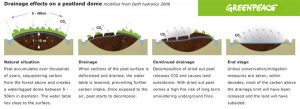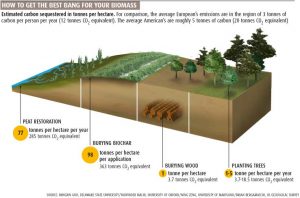Source: eastafricasisal.com
Published: March 6, 2017
What are peatlands?
Peatlands, or mires, are areas of wetland that are covered by peat forming vegetation. Over thousands of years, the decomposed vegetation slowly accumulates in layers to form peat, capable of absorbing and storing carbon.

The impact of drainage channels on peatland (Greenpeace, available at http://www.greenpeace.org/seasia/stop-the-haze/)
Peatlands cover approximately 15% of the UK and provide an important natural habitat for wildlife and store of carbon. However the retention of peatland carbon has been significantly decreased due to land management techniques aimed at increasing land productivity, including drainage, prescribed fire, peat extraction, fertilisation and liming (Holden et al., 2007). As a result, currently over 80% of UK peatlands are estimated to be damaged by mismanagement (IUCN, 2016).
Benefits of restoring peatland
It is in the interest of everyone for peatlands to be in a healthy state. By restoring peatlands, levels of erosion can be reduced, preventing the problems that damaged peatlands bring for livestock, game, wildlife landscape and access (IUCN, 2016). Peatlands also provide large upland storage capacity for water, helping to reduce peak discharge during flood events. Sphagnum moss that colonises wet peatland environments acts as a natural filter for drinking water, reducing costs to utilities companies.

The ability of peatland to absorb and store carbon in comparison with other biomass carbon storage techniques (Lovett, R. (3rd May 2008) Burying biomass to fight climate change, New Scientist Magazine).
Peatland restoration is an internationally recognised and cost effective way to help tackle climate change. Although wetlands only cover 6% of the world’s land surface, they amount for 12% of the global carbon pool, and are therefore crucial to helping to mitigate against future climate change. Restoring UK peatlands alone can help to retain up to three billion tonnes of carbon, more than twenty times more than the storage capacity of UK forests.
